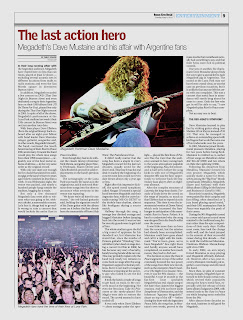No one takes blame
By Pablo Krause
Herald StaffThe cancellation of the visit by Turkish Prime Minister Recep Tayyip Erdogan, who was scheduled to arrive in Buenos Aires yesterday but suspended his trip late on Saturday, led to the governments of President Cristina Fernández de Kirchner and Buenos Aires City Mayor Mauricio Macri swapping the blame.
The CFK administration released a statement late on Saturday citing the cancellation of a ceremony scheduled for this morning to place a bust in honour of Mustafa Kemal Atatürk (the founder of the modern Turkish Republic) as the reason for Erdogan’s decision and blaming the Macri administration for the incident. However, City Hall rejected the accusations and claimed that no such ceremony was scheduled.
Yesterday, the city Foreign Affairs Department released an official statement expressing its regret over the suspension of Erdogan’s visit but insisting that the alleged ceremony was never on City Hall’s schedule.
“In reference to the statements of the Foreign Ministry, we insist the alleged ceremony as well as the placing of a bust of former Premier Atatürk was never authorized or communicated to that Ministry or the Turkish Embassy and it would have required a law approved by the local legislature in order to carry it out,” read the statement.
Asked by the Herald about the incident, PRO Foreign Affairs Secretary Diego Guelar said: “The Turkish Embassy requested permission from the Public Space Ministry to erect a monument to Atatürk about six months ago, allegedly in replacement of an existing bust, but the ministry confirmed there was no previous bust so the request did not progress.”
Guelar claimed: “There was never any ceremony scheduled neither was there an existing Atatürk bust to replace” and insisted such a bill would have needed the approval of the Mayor and the city legislature.
“There was no such ceremony on the schedule of Mauricio (Macri) for Monday,” Guelar told the Herald.
“We don’t know why the tribute was in the Ambassador’s agenda because it would have required a resolution signed by Macri, which he didn’t,” added the Foreign Affairs Secretary of PRO.
Guelar claimed City Hall became aware of the ceremony on Friday when the Armenian community requested an interview with Environment and Public Space Minister Diego Santilli to protest against the display of the Turkish founder’s bust, which was due to be unveiled in a park at the intersection of Figueroa Alcorta and Sarmiento avenues.
The Armenian community published a paid ad in a local newspaper on Saturday, repudiating Erdogan’s visit and making reference to the inauguration of Atatürk’s statue. Later on Saturday, the Foreign Ministry confirmed the Turkish Prime Minister had cancelled his visit and said Erdogan took offence at “a decision by Buenos Aires Mayor Mauricio Macri to cancel a scheduled tribute in which he was to take part.”
Foreign Ministry sources consulted by the Herald yesterday denied the City Hall statements and insisted the ceremony was part of Erdogan’s agenda for his visit.
Sources claimed Erdogan himself told Taiana in Brazil the suspension of the ceremony was the reason of his cancellation.
In statements to local media, Turkish Ambassador to Buenos Aires Hayri Hayret Yalav said the procedures for the monument “started in November, 2009 and there was no problem until yesterday (for Saturday) when Santilli informed me in a letter that the monument would not be placed.”
News agency Reuters reported Turkey’s Foreign Ministry confirmed in a statement the two-day visit scheduled had been cancelled and blamed the move on Armenian lobbyists.
“The trip was cancelled because written permission for the monument given to Turkey beforehand by the Buenos Aires district was reversed as a result of initiatives by the Armenian lobby, which is opposed to Turkey,” said the statement, adding Turkey hoped Argentina would take steps to remove the shadow cast on Turco-Argentine relations.
According to Reuters, President Fernández de Kirchner spoke with Erdogan to explain she could not overrule the decision, yet he found this unacceptable and decided not to go, the statement added.
The Herald was unable to reach Turkish Embassy sources yesterday but a brief statement was released informing the cancellation of a forum at a downtown hotel where Erdogan was scheduled to participate, quoting “last-minute changes in the Prime Minister’s agenda.”
Despite the official explanations and the exchange of accusations between the city and national governments, several rumours spread about the reasons behind Erdogan’s cancellation.
City Hall sources which requested not to be named said the incident “could have been a misunderstanding on the part of the Turkish Embassy, which might have assumed the ceremony was already scheduled, despite having received no confirmation from the city government.”
On the other hand, a source from the Foreign Ministry consulted by the Herald, who also requested that their name not be published, said there was “a verbal agreement” between Macri and the Turkish Embassy for the ceremony but the city administration decided to cancel it following the protests of the Armenian community.
Mustafa Kemal Atatürk, the first Turkish President and founder of the Republic of Turkey, is highly revered by Turks, but Armenians cite him as one of the main culprits for the mass killing of Armenians in 1915, known as “the Armenian Genocide.”
All officials consulted agreed the cancellation was a serious incident and an offence to the Turkish Prime Minister, comparing the situation to a last-minute suspension of a monument to national independence hero José de San Martín or a memorial of the Malvinas War during the visit of an Argentine president to a foreign country.
Some observers had even cited a possible link between the cancellation of Erdogan’s visit and the nuclear fuel agreement signed by Iran — which Brazil and Turkey have supported despite the protests from the United States and on which Argentina has not yet taken a position. However, all sources consulted by the Herald denied such possibility both on and off the record.
Link:
http://www.buenosairesherald.com/BreakingNews/View/35044









.jpg)

